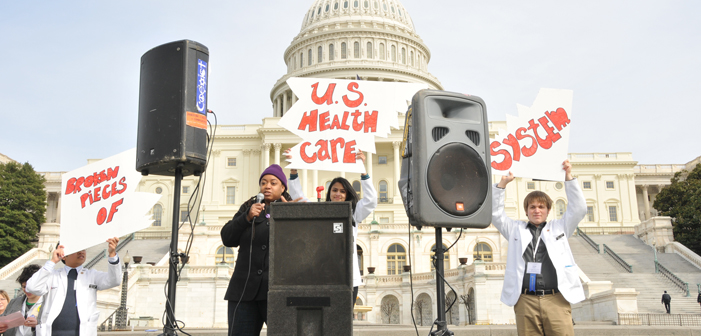Health professionals encounter patients everyday who are unable to afford their medications. It can lead to a feeling of helplessness, for both the health provider and patient involved. But, you can take steps to put patients over profits through advocacy!
Justin Mendoza, State Partnerships Manager at Families USA, shares that he was looking up a testimony that was filed in Connecticut last year where a drug price transparency bill was passed, and one of the pieces of testimony came from a doctor. The doctor spoke to this story of a patient called “Mr. L,” who came into a primary care clinic a year ago with poorly controlled diabetes. “Mr. L” had several diabetes-related complications, including a heart attack, multiple bone infections, and lengthy hospital stays.
What the doctor points out, Justin says, is that each of those things affect “Mr. L’s” ability to hold down a steady job, and have a steady income; and therefore, as a vicious cycle, affects his ability to pay for high-priced drugs to treat his diabetes to begin with.
It sounds like “Mr. L” has a lot on his mind, right? Where will he find the time to fight for lower drug prices? He probably won’t. And that’s where you come in. Physicians, medical professionals, and medical students have the power to raise their voices on their patients behalf.
So, how can you get started?
It can be daunting. The thought of taking on Congress is intimidating, particularly on a huge issue like drug pricing. Steve Knievel, an advocate for Public Citizen’s Access to Medicines program, is an expert in policy matters affecting drug pricing and access to medicines in the United States; and below, Steve joins Justin in discussing the Medicare Negotiation and Competitive Licensing Act and how you can get involved as a future physician.
Plus, Justin shares five steps you can take as a advocate – from most to least effective – to effect change on any given policy issue:
1. Direct face-to-face meeting.
Or, if you can’t get a face-to-face meeting, take a phone call with a senior staff member who works on the issue that you care about in the congressional office that represents you.
If you’re not sure who your representative is, you can find out on govtrack.us or congress.gov by searching your address.
Not only has Justin seen this in action, but he says the facts back it up as the most effective way to make a difference. Based on a survey of congressional staff by the Congressional Management Foundation, 97% at the federal office level and 94% at the district/state office level said constituent visits to the office have some or a lot of influence on an undecided member.
That means meeting with real voters – or YOU! – is one of the most powerful tools to make sure legislators understand what’s important.
2. Written or published materials on the issue, that make it local and compelling.
The second most effective step you can take is writing an op-ed or letter to the editor. These are pieces that you can publish in your name, with your level of expertise, talking about what you’ve seen in the clinic, and tying it back to the issue at hand.
You can de-identify patients, Justin says, just like “Mr. L” in the story above. Once you’ve written the letter, take the next step and send it to the staff person that you would’ve otherwise met with.
3. Calling the office.
When you call the office to support a bill, the most effective time to do it is right when it’s coming up for a vote. Know when legislation is coming up for a vote (for example, you can sign up to be alerted through Families USA!) so that you can just pick up a phone and call the Congressional switchboard at (202) 224-3121.
Justin says this is particularly effective when done in large numbers! So, get your friends together and you can all chime in.
You can also send an email to the office. Write up a letter with a personalized story and let them know why you care so much about the piece of legislation.
4. Signing petitions or form letters.
Though it’s quick to sign and share a petition, it doesn’t always hold that personalized sentiment. It doesn’t give the flavor of living in the community, or pull the larger data to show the size of the issue at hand.
If you sign or circulate a petition, make sure you take that – with stories! – and bring it to the office directly.
5. Tweeting at or tagging a legislator or office on Facebook.
Comments can be deleted or ignored. Sometimes it’s useful to broaden the awareness among constituents but it’s not as effective as the steps above for reaching your legislators.

